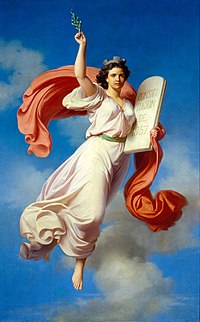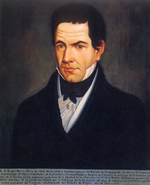Liberalism in Mexico

| Part of a series on |
| Liberalism |
|---|
 |
History
Nineteenth-century Mexican liberalism
The term "liberal" became the name of a political faction, which previously had called itself "the Party of Progress" in contrast to the
Most Mexican liberals looked to European thinkers in their formulation of their ideology, which has led to a debate about whether those ideas were merely "Mexicanized" versions.

With Mexico's defeat in the
Pragmatic politicians, preeminently
With the ouster of the French in 1867 and the discrediting of Mexican conservatives who had supported the regime of foreign monarch
With that major liberal victory won, a third generation of liberals emerged during the presidency of liberal general and military hero of the Second French intervention in Mexico,
Liberalism in the 20th century

As the Díaz regime became increasingly dictatorial and trampled on the rights and liberties of Mexicans, a group of Mexican oppositionists led by
At the outbreak of the uprising against Díaz, the opposition pointed to his continued re-election and abrogation of the liberal Constitution of 1857. Francisco Madero was brought to power by revolutionary forces, but he had hoped to proceed via the constitutional path with election. With the ouster of Díaz, his resignation and exile, Madero agreed to an interim government until new elections could be held in fall 1911. He won the presidency overwhelmingly. He lifted censorship of the press, suppression of strikes, and other measures that Díaz had employed to keep dissent in check. Madero was overthrown in
Major liberal leaders
- José María Luis Mora – Vicente Guerrero – Melchor Ocampo – Valentín Gómez Farías – Benito Juárez – Juan Álvarez – Guillermo Prieto – Miguel Lerdo de Tejada – Sebastián Lerdo de Tejada – Ignacio Manuel Altamirano – Porfirio Díaz – José Yves Limantour – Justo Sierra – Francisco I. Madero - José María Pino Suárez - Gustavo A. Madero
Gallery of liberal leaders
-
Fernández de Lizardi (1776–1827)
-
Valentín Gómez Farías (1781–1858)
-
Vicente Guerrero (1782–1831)
-
Lorenzo de Zavala (1788–1836)
-
Juan Álvarez (1790–1867)
-
José María Luis Mora (1794–1850)
-
Benito Juárez (1806–1872)
-
Miguel Lerdo de Tejada (1812–1861)
-
Ignacio Comonfort (1812–1863)
-
Melchor Ocampo (1814–61)
-
Guillermo Prieto (1818–1897)
-
Ignacio Ramírez (1818–1879)
-
Gabino Barreda (1818–1881)
-
José María Iglesias (1823–1891)
-
Sebastián Lerdo de Tejada (1823–1889)
-
Porfirio Díaz (1830–1915)
-
Vicente Riva Palacio (1832–1896)
-
Manuel González (1833–1893)
-
Ignacio Altamirano (1834–1893)
-
Justo Sierra (1848–1912)
-
José Yves Limantour (1854–1935)
-
Francisco I. Madero (1873–1913)
-
José María Pino Suárez (1869–1913)
-
Ricardo Flores Magón (1874–1922)
Further reading
- Bazant, Jan. Alienation of Church Wealth in Mexico: Social and Economic Aspects of Liberal Revolution, 1856-1875. Cambridge: Cambridge University Press 1971.
- Berry, Charles R. The Reform in Oaxaca, 1856-1876: A Microhistory of the Liberal Revolution. Lincoln: University of Nebraska Press 1981.
- Britton, John. "Liberalism" in Encyclopedia of Mexico, Chicago: Fitzroy Dearborn 1997, pp. 738–742.
- Caplan, Karen D. Indigenous Citizens: Local Liberalism in Early National Oaxaca and Yucatán. Stanford: Stanford University Press 2010.
- Chevalier, François. "Conservateurs et libéraux au Mexique. Essai de sociologie et géographie politiques de l'indepéndence a l'intervention françcaise," Cahiers d'histoire mondiale, 8(1964).
- Coatsworth, John. Growth Against Development: The Economic Impact of Railroads in Porfirian Mexico. DeKalb: Northern Illinois University Press 1980.
- Hale, Charles A. Mexican Liberalism in the Age of Mora, 1821-53. Yale University Press (1968)
- Hale, Charles A. The Transformation of Liberalism in Late Nineteenth-Century Mexico. Princeton University Press (1989)
- Hamnett, Brian. Juárez. London: Longman 1994.
- Jackson, Robert L. Liberals, the Church, and Indian peasants: Corporate lands and the challenge of reform in nineteenth-century Spanish America. Albuquerque : University of New Mexico Press, 1997.
- Katz, Friedrich, "The Liberal Republic and the Porfiriato, 1867-76" in Mexico Since Independence, Leslie Bethell, ed. New York: Cambridge University Press 1991, pp. 49–124.
- Knight, Alan. "El Liberalismo mexicano desde la reforma hasta la revolución (una interpretación)." Historia Mexicana 35(1985):59-91.
- Knowlton, Robert J. Church Property and the Mexican Reform, 1856-1910. DeKalb: Northern Illinois University Press 1976.
- Olliff, Donathan C. Reforma Mexico and the United States: A Search for Alternatives to Annexation, 1854-1861. University of Alabama Press 1981.
- Perry, Laurens Ballard. Juárez and Díaz: Machine Politics in Mexico. DeKalb: Northern Illinois University Press 1978
- Powell, T.G. El Liberalismo y el campesinado en el centro de México, 1850-1876'. Mexico City: Secretaría de Educación Pública 1974.
- Powell, T.G. "Mexican Intellectuals and the Indian Question, 1876-1911." Hispanic American Historical Review 40(1968): 19–36.
- Reyes Heroles, Jesús. El Liberalismo mexicano. 3 vols. Mexico City: UNAM 1957–61.
- Richmond, Douglas W. Conflict and carnage in Yucatán: Liberals, the Second Empire, and Maya revolutionaries, 1855-1876. Tuscaloosa, Alabama : The University of Alabama Press, 2015
- Rodríguez, Jaime. The Divine Charter: Constitutionalism and Liberalism in Nineteenth-century Mexico. Lanham, Md.: Rowman & Littlefield Publishers, 2005.
- Schoonover, Thomas David, Dollars over dominion: The triumph of liberalism in Mexican-United States relations, 1861-1867. Baton Rouge: Louisiana State University Press, 1978.
- Sinkin, Richard. The Mexican Reform, 1855-1876: A study in Liberal Nation-Building. Austin: University of Texas Press 1979.
- Tenenbaum, Barbara. The Politics of Penury: Debt and Taxes in Mexico, 1821-1856. Albuquerque: University of New Mexico Press 1986.
- Topik, Steven. "The Economic Role of the State in Liberal Regimes: Brazil and Mexico Compared, 1888–1910," in Guiding the Invisible Hand: Economic Liberalism and the State in Latin American History, Joseph L. Love and Nils Jacobsen, eds. New York 1988, 117–44.
- Thomson, Guy P. C., Patriotism, politics, and popular liberalism in nineteenth-century Mexico: Juan Francisco Lucas and the Puebla Sierra. Wilmington, Del.: Scholarly Resources, 1999.
See also
- History of Mexico
- History of democracy in Mexico
- Politics of Mexico
- History of Roman Catholicism in Mexico
- Economic history of Mexico
- Liberal Reform
- Constitution of 1857
- Reform laws
- Reform War
- List of political parties in Mexico
- Education in Mexico
- Porfiriato
- Porfirionism
- Index of Mexico-related articles
References
- ^ John Britton, "Liberalism" in Encyclopedia of Mexico, Chicago: Fitzroy Dearborn 1997, 738.
- ^ Perry, Laurens Ballard. Juárez and Díaz: Machine Politics in Mexico. DeKalb: Northern Illinois University Press 1978, 340-41
- ^ Perry, Juárez and Díaz, 342
- ^ Olliff, Donathan C. Reforma Mexico and the United States, 4
- ^ Krauze, Enrique, Mexico: Biography of Power. New York: HarperCollins 1997, p. 13.
- ^ Hale, Charles A., Mexican Liberalism in the Age of Mora, 1821–1853. New Haven: Yale University Press 1968.
- ^ Olliff, Reforma Mexico, 4
- ^ Hale, Charles A. The Transformation of Mexican Liberalism in Late Nineteenth-Century Mexico. Princeton: Princeton University Press 1989, p. 19.
- ^ Olliff, Donathan C. Reforma Mexico and the United States: A Search for Alternatives to Annexation, 1854-1861. Tuscaloosa: University of Alabama Press 1981.
- ^ Hale, Charles A. Mexican Liberalism in the Age of Mora. New Haven: Yale University Press 1968, 39.
- ^ Hale, Charles A. The Transformation of Liberalism in Late Nineteenth-Century Mexico. Princeton: Princeton University Press 1989.
- ^ Britton, "Liberalism" p. 738.
- ^ Krauze, Mexico: Biography of Power, p. 14.
- ^ Krauze, Mexico: Biography of Power, p. 14.
- ^ Britton, "Liberalism" pp. 742.
- ^ James A. Sandos, "Patrido Liberal Mexicano (PLM)" in Encyclopedia of Mexico, vol. 2, pp. 1055–1057. Chicago: Fitzroy Dearborn 1997.

























